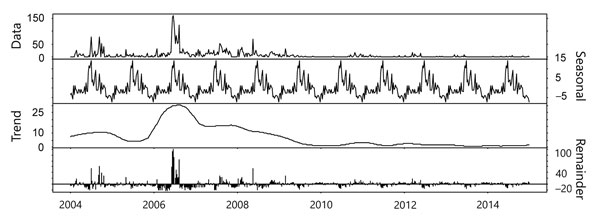Volume 24, Number 2—February 2018
Synopsis
Ecologic Features of Plague Outbreak Areas, Democratic Republic of the Congo, 2004–2014
Figure 5

Figure 5. Time series decomposition using LOESS regression for bubonic plague, Orientale Province, Democratic Republic of the Congo, 2004–2014. Plague did not vary seasonally. The trend was decreasing after 2006. Remainder (residuals) explained 63% of model variance, trend 22% and seasonality 8% only.
Page created: January 17, 2018
Page updated: January 17, 2018
Page reviewed: January 17, 2018
The conclusions, findings, and opinions expressed by authors contributing to this journal do not necessarily reflect the official position of the U.S. Department of Health and Human Services, the Public Health Service, the Centers for Disease Control and Prevention, or the authors' affiliated institutions. Use of trade names is for identification only and does not imply endorsement by any of the groups named above.